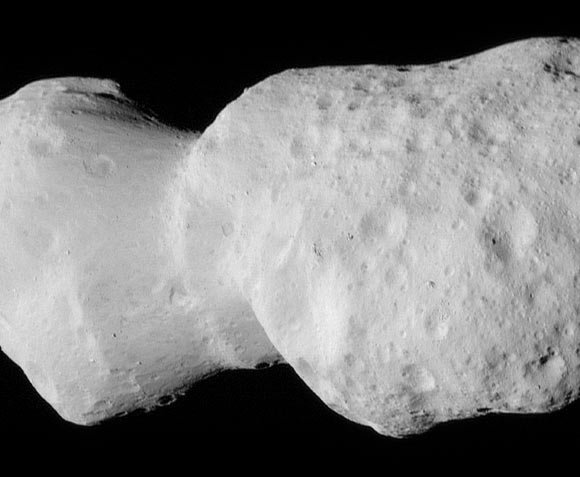An asteroid called Donaldjohanson was captured by NASA’s Lucy spacecraft during a flyby on April 20, 2025. At closest approach, the spacecraft came within a distance of 960 km (600 miles).
Donaldjohanson is a carbonaceous asteroid located in the inner regions of the main asteroid belt.
It was first discovered on March 2, 1981 by the American astronomer Schelte Bus at the Siding Spring Observatory.
Donaldjohanson was previously observed to have large brightness variations over a 10-day period, so some of Lucy team members’ expectations were confirmed when the first images showed what appeared to be an elongated contact binary — an object formed when two smaller bodies collide.
However, the researchers were surprised by the odd shape of the narrow neck connecting the two lobes, which looks like two nested ice cream cones.
“Asteroid Donaldjohanson has strikingly complicated geology,” said Lucy principal investigator Dr. Hal Levison, a researcher at Southwest Research Institute.
“As we study the complex structures in detail, they will reveal important information about the building blocks and collisional processes that formed the planets in our Solar System.”

This image of the asteroid Donaldjohanson was captured by the Lucy Long-Range Reconnaissance Imager (L’LORRI) on April 20, 2025, near closest approach, from a range of 1,100 km (660 miles). Image credit: NASA / Goddard / SwRI / Johns Hopkins APL / NOIRLab.
From a preliminary analysis of the first available images collected by the spacecraft’s L’LORRI imager, Donaldjohanson appears to be larger than originally estimated — about 8 km (5 miles) long and 3.5 km (2 miles) wide at the widest point.
“In this first set of high-resolution images returned from the spacecraft, the full asteroid is not visible as the asteroid is larger than the imager’s field of view,” the scientists explained.
“It will take up to a week for the team to downlink the remainder of the encounter data from the spacecraft; this dataset will give a more complete picture of the asteroid’s overall shape.”
“These early images of Donaldjohanson are again showing the tremendous capabilities of the Lucy spacecraft as an engine of discovery,” said Lucy program scientist Dr. Tom Statler, a researcher at NASA Headquarters.
“The potential to really open a new window into the history of our Solar System when Lucy gets to the Trojan asteroids is immense.”
Like Lucy’s first asteroid flyby target, Dinkinesh, Donaldjohanson is not a primary science target of the mission.
As planned, the Dinkinesh flyby was a system’s test for the mission, while this encounter was a full dress rehearsal, in which the team conducted a series of dense observations to maximize data collection.
Data collected by Lucy’s other scientific instruments, the L’Ralph color imager and infrared spectrometer and the L’TES thermal infrared spectrometer, will be retrieved and analyzed over the next few weeks.
The Lucy spacecraft will spend most of the remainder of 2025 travelling through the main asteroid belt.
Lucy will encounter the mission’s first main target, the Jupiter Trojan asteroid Eurybates, in August 2027.











